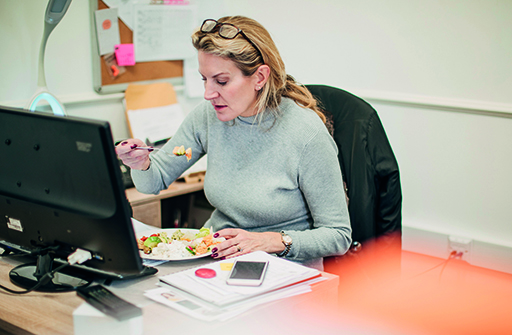Time for lunch €“ or do you work through?
In Insight
Follow this topic
Bookmark
Record learning outcomes
Do you work through lunch more often than you would like? Is it something that you’ll do when it’s needed, or does your employer actually expect it of you? Rest breaks have become a hot topic, explains pharmacist Ross Ferguson
Who could really argue with the Pharmacists’ Defence Association’s (PDA) Safer Pharmacies Charter for a safer working environment?
- No self-checking
- Safe staffing
- Access to a pharmacist
- Adequate rest
- Respect for professional judgment
- Raising concerns
- Physical safety.

In asking employers, the GPhC and Government to support the commitments outlined in the charter, the PDA is hoping to ensure safer working environments that will lead to better safety for patients. But equally importantly, the union is keen for pharmacy organisations to promote the campaign to the public.
I have signed up to the charter, but it is clear that not everyone has, or there are certainly some misunderstandings about what can compromise safety. Few pharmacists would have been surprised recently to see the PDA highlight that one locum agency was advising locums that they are more likely to get a booking if they indicate they were willing to forego a lunch break — the implication was that pharmacy owners were actively encouraging pharmacists to work through their lunch.
Time for tea?
In my many years of working in community pharmacy I have only ever worked in one pharmacy that closed for lunch (that wasn’t the one I owned). I was available all day without a break. Meanwhile all the other staff with zero professional obligations had two tea breaks a day and a lunch hour. I did it so as not to inconvenience people, but on reflection this was not the right approach.
We’ve all been there – half eaten sandwich (or more likely just opened the wrapper) and a prescription needs to be checked, someone wants to speak to the pharmacist, a staff member wants some advice, the phone rings, or the delivery arrives. There are constant interruptions.
As a minimum, the Working Time Regulations require workers to get a 20-minute rest break if the working day is longer than six hours – how many pharmacists actually get this?
So, if we accept that a rest break is necessary, does it need to be a complete removal from the work environment? If not, where do we draw the line? Checking an urgent prescription for a palliative care patient? And what about supervising OTC sales, or giving out a prescription waiting to be collected? Can those be done if the pharmacist takes a lunch break? How do we square bullets three and four on the PDA charter?
Decisions to be made
You can see the obvious conundrum here — taking a break may mean that normal activities may have to cease temporarily while pharmacists take essential breaks, or they continue without the pharmacist being able to intervene. That itself creates its own set of questions and implications.
Perhaps this is where the publicity is needed – to educate pharmacy users that pharmacists are human and for their own safety must have breaks and that during these times some pharmacy services may be unavailable.
For pharmacy owners, safety has to be the priority, but is a proper one-hour lunch break feasible? An added bonus would be that it would save some much-needed cash for pharmacies that no longer pay their pharmacists or locums to work through lunch. No doubt the financial implications would be unwelcome by some, however we can’t allow the appeal of cash to win over safety.
Every pharmacist needs to consider not just what is acceptable to them, but what is safe, what is professional, and what is not. Patient safety is paramount and as a profession we need to confront this issue from all sides: locums, managers, employers, and professional organisations. What will you commit to?
